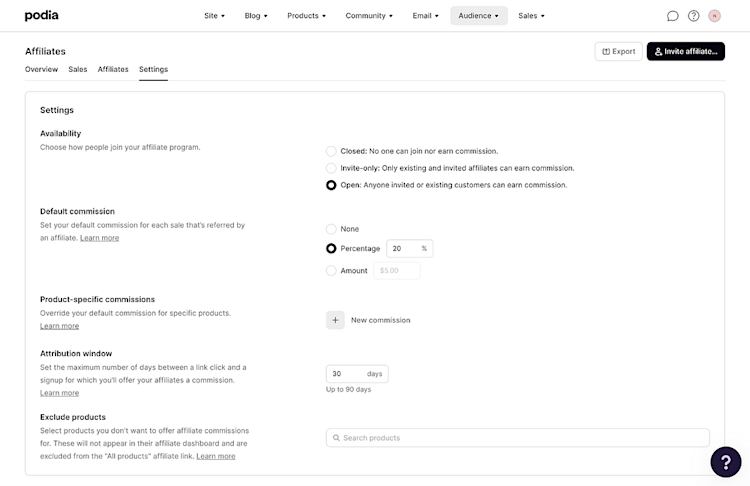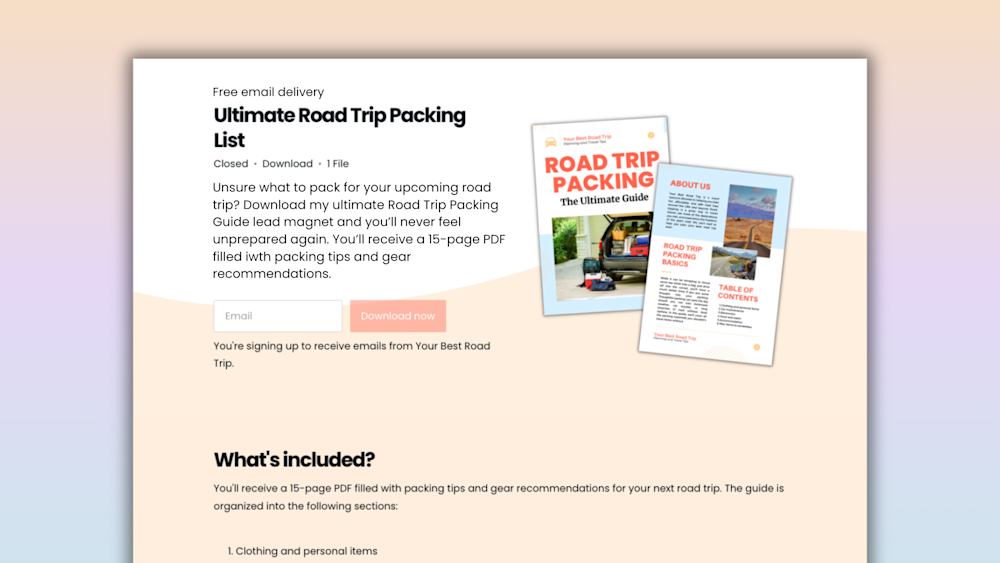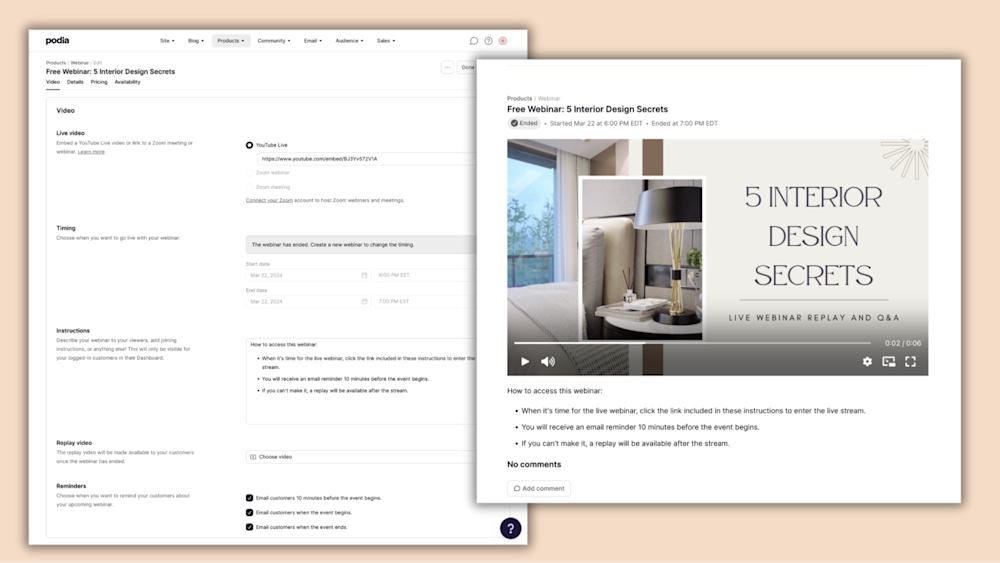You only have to scroll through Instagram or YouTube to see how effective affiliate marketing can be. Any time a video tells you to “buy through the link”, there’s a good chance the creator is an affiliate, which means they get a commission for each sale they make.
These days, it’s not hard to set up your own affiliate program for your products. Our data shows that Podia users with affiliate programs earn over $75/month from their affiliates alone. (Which completely covers the cost of an annual Podia Shaker plan!)
In total, affiliate programs run on Podia have generated almost 8 million dollars in revenue for users, and some of the highest-earning programs have brought in over $100,000 in affiliate-driven sales.
And audience size doesn’t necessarily matter.
That’s because the most effective creators and solopreneurs use an affiliate program as part of a broader system that connects their digital products, marketing efforts, and audience.
In this article, we’ll cover:
-
The basics of creating an affiliate program in Podia, including setting commission rates and recruitment strategies
-
Advanced tips for integrating affiliates into your business’s marketing flywheel
-
Expert advice from creators making real money through Podia’s affiliate tools
By the end, you’ll have a clear plan to launch an affiliate program that boosts your revenue and builds strong partnerships — all while staying simple to manage.
Affiliate marketing isn’t complicated when everything is connected
Wouldn’t it be amazing if more people knew about your business without you having to spend countless hours and dollars on marketing?
An affiliate program can get more eyes on your work without any upfront costs, but often, the software to manage it is complicated and expensive.
You have to connect third-party affiliate platforms to your existing products and website, integrate with payment processors, and get your affiliates to sign up for yet another platform… all while paying for another tool.
Your affiliate program is supposed to make your life easier and earn you money — not be another thing you have to deal with.
For an affiliate program to make sense, it should be already connected to the work you’re doing. And it should be easy to use.
According to Podia customer Robert Williams, people asked him to make an affiliate program for years, but the tools to run it were so complicated and hard to manage that he turned them away. But when he found Podia (and started using the built-in affiliate tool), he was able to set up the program in just a few clicks.
Robert says, “It’s an easy way to boost revenue with very little extra work. Each month, affiliates (and I) make about $1,000+ more in revenue as a result of Podia’s affiliate feature. It’s a great way to give people a reason to share your product.”

So let’s get the word out about what you offer so you can grow with affiliates too.
You can create your affiliate program, including setting commission rates and recruiting affiliates, in 4 steps
Podia makes it easy to build an affiliate program for your business in just a few clicks, and we’ll keep track of your affiliate info, links, products sold, and the amount to be paid out to affiliates.
Here’s how to set it up.
Step 1: Upgrade to the Shaker plan to unlock affiliate marketing
Affiliate features are included in Podia’s Shaker plan, which costs $89/month or $75/month when you pay annually.
On average, Podia customers who use affiliates in their business earn back the cost of the Shaker plan (and more) each month, so you could end up saving money.
Step 2: In the “Audience” tab, click “Affiliates” to see your affiliate dashboard
In your main Podia dashboard, click on “Audience” and select “Affiliates.” Here you can keep an eye on how all your affiliates are performing, track payouts, and see total affiliate sales. You’ll also see a button where you can invite affiliates to join your program via email or via a special sign-up link.

Step 3: Use the “Settings” tab to set the rules of your affiliate program
Click on the “Settings” tab in your affiliate dashboard to customize your affiliate program. You can adjust:
-
Availability: Is your program open to everyone, closed, or invite only
-
Commission structure: What’s the default commission for each sale that’s referred by an affiliate
-
Product-specific commissions: If you’d like to make a different commission plan for a certain product
-
Attribution window: Set the maximum number of days between a link click and a signup for which you’ll offer your affiliates a commission (up to 90 days)
-
Exclude products: Select products you don’t want to offer affiliate commissions for. These will not appear in their affiliate dashboard and are excluded from the “All products” affiliate link.

With your affiliate program customized exactly the way you like, the last step is to invite new affiliates to join your program.
Step 4: Invite affiliates to your program via email, and watch the sales roll in
Click the “Invite affiliate” button in your dashboard to send an email invitation to anyone you want to invite to your program. You’ll also be given a unique website link that you can share with people so they can sign up directly.
Once an affiliate joins your program, they’ll see their own personal dashboard with your business. Here they’ll be able to copy their custom referral link for each product you’ve given them access to, and they can share that link with their audience. Podia handles the tracking so if someone makes a sale through their unique link, you’ll be able to give them their commission.

Podia makes managing your affiliates easy because everything is already connected. You don’t have to pay for third-party tools and worry about complicated integrations, and you can give your affiliates access to more products, change their commission rates, send email announcements, and track payouts all in the same place.
Advanced tips for integrating affiliates into your business’s marketing strategy (so your affiliates make sales on autopilot)
Even if you build the perfect affiliate program, it can be tricky to keep people enthusiastically promoting your work.
Podia creator Brittany Hardy says, “You have to give the affiliate program attention if you want it to actually move the needle. You can’t just set it and forget it. You have to continuously nurture your affiliates and tell them exactly what you need them to do.”
Here’s how successful small business owners like Brittany are giving their affiliates the best chance of success and earning more in the process.
Give your affiliates ready-to-share assets
Make things as easy as possible for your affiliates by providing them with links, swipe copy, graphics, blog post templates, and resources directly within Podia. You can use your website builder to make an affiliate resource page or put everything into a free product for easy access.
Robert Williams (who makes over $1,000 per month in affiliate revenue) uses a course to share helpful resources and ensure his affiliates are successful.
“I created a free course called affiliates, which gives anybody who signs up access to some material and instructions for how to get started with my affiliate program. It has email campaign instructions on how to set up your affiliate link and things like that,” he explains.
Seek out strong affiliate matches and reach out to them directly
Photographer and marketing instructor Jerad Hill grew his affiliate program by doing 1:1 outreach to other creators in his niche (especially bloggers with audiences like his).
“I created a course for a specific niche, so I reached out to bloggers who cover that topic and offered them a percentage of the sale that was too good to refuse,” he shares.
“They are used to 15% or less, and many focus on products with even smaller affiliate earnings. I offered 50% of the course purchase price, and I got a response from 75% of the blogs I contacted.”
A good affiliate offer plus a relevant product can mean big bucks for you and other creators in your niche.
Track affiliate success and take care of your top earners
Podia comes with built-in analytics so you can see which affiliates drive the most traffic and sales. Reach out to these people to see how you can continue to support their efforts. Maybe you offer a special discount code just for their followers or offer a freebie that they can give away to drive sales. Whatever they’re doing is working, so lean into it and learn from it.
Integrate affiliates with your email marketing
Set up an automated email campaign that runs a few weeks after someone purchases your products. In this campaign, remind students that they can join your affiliate program and tell them how to sign up. Sometimes people just need a little nudge to start sharing and reminding them a few weeks after they finish the course keeps you top of mind.
Build strong relationships with your affiliates
Use Podia’s email tools to communicate with affiliates, celebrate wins, share product announcements, and give updates.
In Podia Email, all you need to do is create a new broadcast and choose “Affiliates” as the audience filter to send a message to people in your affiliate program. You don’t need to do any fancy tagging or segmenting unless you want to.
What if affiliate management was the easiest part of your business?
If you’ve ever thought, “I wish more people knew about my business” or “I wish my students would tell their friends about my course,” you’re not alone.
Starting an affiliate program is an easy way to increase your reach and find new customers who love your work.
With Podia, managing your affiliates is as easy as logging into your Podia account. Everything is connected so you don’t have to learn new software, and on average, business owners with affiliate programs on Podia earn enough from those affiliates to cover their software expenses each month.
Because everything is built in, it’s simple to give affiliates access to some or all of your products, connect with them through email marketing, track affiliate sales, and provide them with materials and encouragement to keep the money coming.
Try Podia free for 30 days and see what affiliates could mean for your business.



